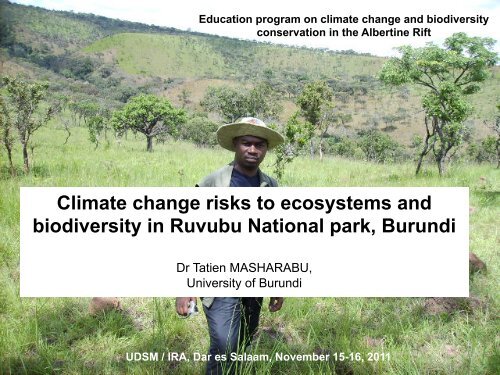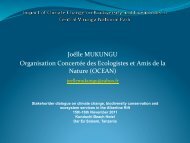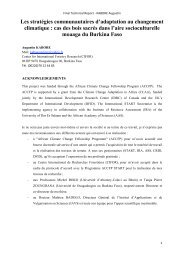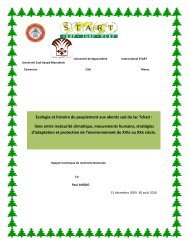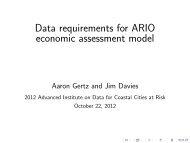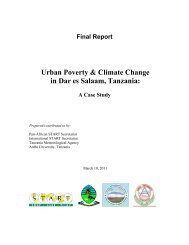Download Presentation
Download Presentation
Download Presentation
Create successful ePaper yourself
Turn your PDF publications into a flip-book with our unique Google optimized e-Paper software.
Education program on climate change and biodiversity<br />
conservation in the Albertine Rift<br />
Climate change risks to ecosystems and<br />
biodiversity in Ruvubu National park, Burundi<br />
Dr Tatien MASHARABU,<br />
University of Burundi<br />
UDSM / IRA, Dar es Salaam, November 15-16, 2011
Study area (1/2)<br />
Temperature (°C)<br />
- Ruvubu National Park (RNP)<br />
- Covers an area of 50800 ha<br />
- Altitudes: 1350-1836 m<br />
- Tropical climate classified as (AW3)s<br />
- RNP established since 1980<br />
- Category II according to UICN (1994)<br />
- Main ecosystems types: savannahs<br />
(~85%), forest galeries and swamps<br />
- Little study and data on climate change<br />
100<br />
80<br />
60<br />
40<br />
20<br />
0<br />
J F M A M J J A S O N D<br />
Month<br />
200<br />
160<br />
120<br />
80<br />
40<br />
0<br />
Rainfall (mm)<br />
Rainfall<br />
Temperature<br />
2
Study area (2/2)<br />
(c) Bucorvus leadbeateri<br />
(Bucerotidae)<br />
(a) Syncerus caffer<br />
(Bovidae)<br />
(b) Kobus ellipsiprymnus defassa<br />
(Bovidae)<br />
(d) Cercopithecus aethiops<br />
(Cercopithecidae)<br />
Last refugia of large mammals in Burundi; Important Bird<br />
Area, Ten bird species on IUCN redlist, Potential Ramsar<br />
Site.<br />
Victim of poaching<br />
3
Objectives<br />
General aim:<br />
To assess impacts of climate change and climate variability on the flora<br />
and vegetation of the RNP.<br />
Specific aims:<br />
To assess trends in rainfall and temperature variations recorded for a 10<br />
years period (1997-2006)<br />
To check out the RNP plant diversity with emphasis on invasive and<br />
ruderal species, as invasive and ruderal species (nitrophilic and<br />
heliophilic) don’t likely occur in naturally disturbed or climax communities<br />
To assess trends of non-climatic stressors as they may be influenced by<br />
climate change<br />
4
Methodology<br />
Data collection<br />
- Meteorological data (rainfall, temperature): 1997-2006 , from IGEBU<br />
- Vegetation and flora survey using Braun-Blanquet method<br />
- Interview park managers for monitoring trends of non climatic stressors<br />
Data analysis<br />
Quantitative analysis<br />
Occurrence of exotic, invasive (Global Invasive Species Database, 2005)<br />
and ruderal species was checked out.<br />
Cluster analysis<br />
SciViews - R and MVSP: to examine trends and seasonal shifts of rainfall<br />
and temperature based on monthly and yearly mean.<br />
5
RESULTS<br />
Yearly mean rainfall and temperature<br />
trends in the RNP (1997-2006)<br />
Sum Sq Df F value Pr(>F)<br />
Province 47911 2 3.2194 0.04124 *<br />
Year 103748 9 1.5492 0.12961<br />
Province: Year 48765 18 0.3641 0.99279<br />
Minimum variance<br />
7200 6000 4800 3600 2400 1200 0<br />
Squared Euclidean<br />
Karuzi<br />
Cankuzo<br />
Muyinga<br />
The park recorded much variability in terms of rainfall. Droughts and floodings<br />
have been coupled during that period and there’s evidence that biodiversity should<br />
have been affected by the changing climate.<br />
There’s a significant difference in terms of rainfall distribution per province (Karuzi,<br />
Muyinga and Cankuzo) but the annual rainfalls fluctuation is a reality even if there’s<br />
no significant difference between provinces, an evidence that all provinces have<br />
been affected by climate variability and indirectly the RNP has been affected.<br />
Temperatures (°C)<br />
750,0<br />
700,0<br />
650,0<br />
600,0<br />
550,0<br />
500,0<br />
450,0<br />
400,0<br />
350,0<br />
300,0<br />
250,0<br />
200,0<br />
150,0<br />
100,0<br />
50,0<br />
0,0<br />
1997<br />
1998<br />
1999<br />
2000<br />
2001<br />
2002<br />
Years<br />
2003<br />
2004<br />
2005<br />
2006<br />
1500,0<br />
1400,0<br />
1300,0<br />
1200,0<br />
1100,0<br />
1000,0<br />
900,0<br />
800,0<br />
700,0<br />
600,0<br />
500,0<br />
400,0<br />
300,0<br />
200,0<br />
100,0<br />
0,0<br />
Rainfall (mm/year)<br />
Rainfall<br />
Temperatures<br />
6
Vulnerabilities and non-climatic stressors<br />
The main issues that the park is facing are: Poaching, Fire & Livestock<br />
grazing ;<br />
… Mining activities (NICKEL) in upcoming years with impacts on<br />
biodiversity, water quality and availability,…<br />
Some fire tolerant and propagated species found in the RNP are:<br />
Combretum collinum (Combretaceae), Combretum molle (Combretaceae),<br />
Protea madiensis (Proteaceae), Cussonia arborea (Araliaceae), Entada<br />
abyssinica (Mimosaceae), Hymenocardia acida (Euphorbiaceae), Parinari<br />
curatellifolia (Chrysobalanaceae)<br />
Along animals corridors and in their resting space, appearance of<br />
nitrophilic species indicating disturbance : Bidens steppia , Guizotia<br />
scabra, Leonotis nepetifolia, Emilia caespitosa, Ageratum conyzoides,<br />
Achyranthes aspera, Conyza floribunda, Gutenbergia cordifolia, Bidens<br />
7<br />
pilosa
Exotic & Invasive species<br />
The major exotic plant found in the RNP is Eucalyptus sp (Myrtaceae):<br />
Eucalyptus plantations are found to be located in the park where people<br />
have been moved out in the 80s.<br />
Lantana camara (Verbenaceae) and Mimosa pigra (Mimosaceae) are the<br />
most potential harmful as they are established not far to the Ruvubu River<br />
and roadsides. Rivers and roads are best corridors for migratory<br />
movements and colonisation.<br />
Other invasive species recorded are Asystasia gangetica (Acanthaceae),<br />
Pennisetum polystachion (Poaceae), Commelina benghalensis<br />
(Commelinaceae), Dioscorea bulbifera (Dioscoreaceae), Imperata<br />
cylindrica (Poaceae) and Melinis minutiflora (Poaceae). They should have<br />
potential invasive effects in the RNP, but for the moment, they are found<br />
as individuals without substantial effects on native species.<br />
8
Conservation implications<br />
• Safeguard of biodiversity, mitigation of climatic and non<br />
climatic stressors on RNP biodiviversity should include<br />
(1) implication of local communities in the park<br />
management; (2) promotion of poverty alleviation<br />
through development initiatives in the RNP<br />
surroundings; and (3) transboundary conservation<br />
initiatives including climatic and non-climatic threats.<br />
• Role of Government (s) and partners, scientific<br />
community, local communities, individuals, NGOs<br />
9
THANK YOU FOR YOUR<br />
ATTENTION<br />
10


